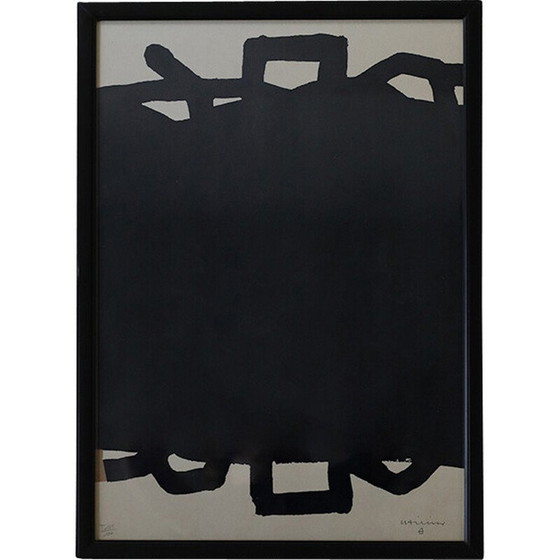Have it delivered hassle-freeBuyer protectionAll items curated by WhoppahDownload the Whoppah app here

Item not as advertised, money backAll items are curated and 100% authenticHave it delivered hassle-free or pick it up yourselfShop only from Trusted Sellers
Business seller
Product description
Eduardo Chillida
Lithograph on cardboard
Number T 169/1000
The work is signed by the artist and individually numbered (pencil)
Work dimensions 47/34
The work is framed
Eduardo Chillida(1924 - 2002). He was a Spanish artist. He began his career in 1943, studying architecture at the University of Madrid, but in 1947 he took up drawing and sculpture. In 1948 he moved to Paris, then the world capital of art. Although he dropped out of college, his work betrays his architectural training, revealing an underlying sense of structural organization as well as material discipline, planning spatial relationships, and scaling elements. For years, the artist used materials that were the basis for his research on conceptual and metaphysical issues. Chillida's early efforts in stone and plaster oscillated between humans and the natural world. His return to the Spanish Basque country in 1951 initiated a change of vision, focusing more on the metamorphosis of space and the definition of spatial volume through form. Chillida soon abandoned the plaster he had used in his Paris works in favor of iron, then wood and steel. These materials represent Basque traditions in industry, architecture and agriculture, and recall the landscape and black light of the region. Chillida began using alabaster for its illuminated but veiled appearance, he used it in the sculpture How Deep is the Air (1996). Despite his use of a variety of media, Chillida's intentions for simplicity and balance never allowed the material to take on a form alien to its nature. He was consistently guided by the quality of space, density and rhythm. Major retrospectives of Chillida's graphic and sculptural works have been exhibited by the Museum of Fine Arts, Houston (1966), the Carnegie Institute, Pittsburgh (1979), the National Gallery of Art, Washington, D.C. (1979), the Guggenheim Museum (1980), the Palacio de Miramar, San Sebastián (1992), and Museo nacional centro de arte Reina Sofía, Madrid (1999). Chillida's monumental sculptures designed for urban and more remote spaces are permanently installed internationally and constitute a central aspect of his artistic production. Chillida has received numerous awards, including the Grand International Sculpture Prize at the Venice Biennale (1958), the Kandinsky Prize (1960), the Carnegie Prize for Sculpture (1964), the Andrew Mellon Prize (1978, with Willem de Kooning), the Grand Award for Arts in France (1984) and the Jack Goldhill Award from the Royal Academy of Arts in London (1996). In 2000, the Chillida-Leku Museum, a monographic exhibition space, was opened in San Sebastián.
Work in original condition. The frame shows minor signs of use.
Work in original condition. The frame shows minor signs of use.
Work in original condition. The frame shows minor signs of use.
Specifications
ConditionGoodColorsCreme, BlackMaterialPaperNumber of items1Height47 cmWidth34 cmDepth2 cmSigns of usageScratches




